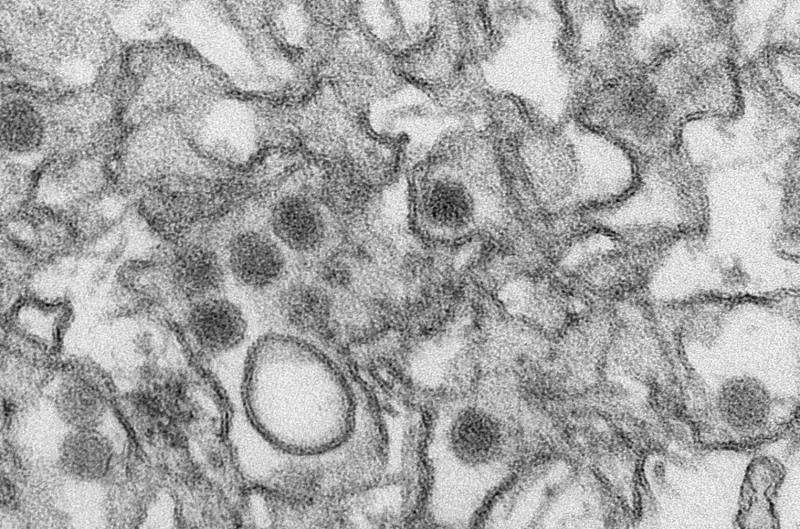Scientists determine how Zika virus causes brain defects and microcephaly

In a groundbreaking study published in Frontiers in Human Neurosciences, a group of clinicians and scientists from All India Institute of Medical Sciences, New Delhi, India (in collaboration with researchers at Dr. B. R. Ambedkar Centre for Biomedical Research, Delhi and National Brain Research Centre, Haryana) have proposed a novel mechanism of Zika virus (ZIKV) mediated microcephaly and indicated the involvement of retinoic acid signaling. ZIKV is a severely pathogenic virus causing many brain malformations including microcephaly in neonates. Owing to the observation that this virus causes many neurological problems and severe birth defects, WHO declared this outbreak as the "Public Health Emergency of International Concern." Since this virus has the ability to get transferred from pregnant women to their fetuses, it has been observed to cause acute brain malformations and microcephaly.
Many countries have advised their citizens to delay pregnancy till the mechanism by which this viruses causes microcephaly is deciphered. Understanding the mechanism of ZIKV mediated microcephaly is an immediate need of the hour that will help in preventing the spread of this epidemic and blocking the disease causing abilities of this virus. Despite a lot of efforts all over the world, the mechanism by which ZIKV causes microcephaly is not known. A group of researchers from India have answered this big question in a pioneering study recently published in Frontiers in Human Neurosciences. A team of scientists headed by Dr. Ashutosh Kumar and Dr. Muneeb Faiq from All India Institute of Medical Sciences, New Delhi has given extremely important insights into this important issue. They have explained a possible mechanism by which ZIKV infection may cause microcephaly in the fetuses of infected women. According to these researchers, the ZIKV interferes with retinoic acid signaling by introducing its genome sequence repeats (called the Retinoic Acid Response Elements or simply RARE consensus repeats) into the developing brain cells of the fetus.
"The rationale of the mechanism of ZIKV-Microcephaly relationship is based on sequence homology between ZIKV genome and the response element of an early neural tube developmental marker (retinoic acid) in human DNA," said Dr. Himanshu Singh, Dr. Khursheed Raza and Dr. Subrahamanyam Dantham. Comprehensive similarities between the details of brain defects in ZIKV-microcephaly and retinoic acid embryopathy is the key link that reveals the mechanism of ZIKV mediated microcephaly," said Vikas Pareek, Pavan Kumar and Sankat Mochan.
Retinoic acid (a metabolite of vitamin A) is one of the earliest factors for regulating anteroposterior axis of neural tube and positioning of structures in developing brain through RARE consensus sequence in promoter regions of retinoic acid-dependent genes. The investigators screened genomic sequences of already reported virulent ZIKV strains and a plethora of other viruses available for the RARE consensus repeats. They obtained results strongly bolstering the hypothesis that ZIKV strains associated with microcephaly may act through dysregulation in retinoic acid-dependent genes by introducing extra stretches of RARE consensus sequence repeats in the genome of developing brain cells. Additionally, they observed that screening of other viruses for RARE consensus sequence repeats is positive only for those known to display neurotropism and cause fetal brain defects. The numbers of RARE sequence repeats had a direct proportional relationship with the virulence of screened positive viruses.
This study is likely to open a new area of research and may prove a game changer in the battle against ZIKV mediated microcephaly. It may also establish a novel mechanism for certain virus mediated diseases. As an obvious conclusion of the arguments presented by these researchers, it will be possible to design vaccines and novel and effective treatments against ZIKV infection. This study may prove to be pivotal in preventing the onset of microcephaly.
More information: Kumar A, Singh HN, Pareek V, Raza K, Dantham S, Kumar P, Mochan S and Faiq MA (2016). A Possible Mechanism of Zika Virus Associated Microcephaly: Imperative Role of Retinoic Acid Response Element (RARE) Consensus Sequence Repeats in the Viral Genome. Front. Hum. Neurosci. 10:403. DOI: 10.3389/fnhum.2016.00403



















